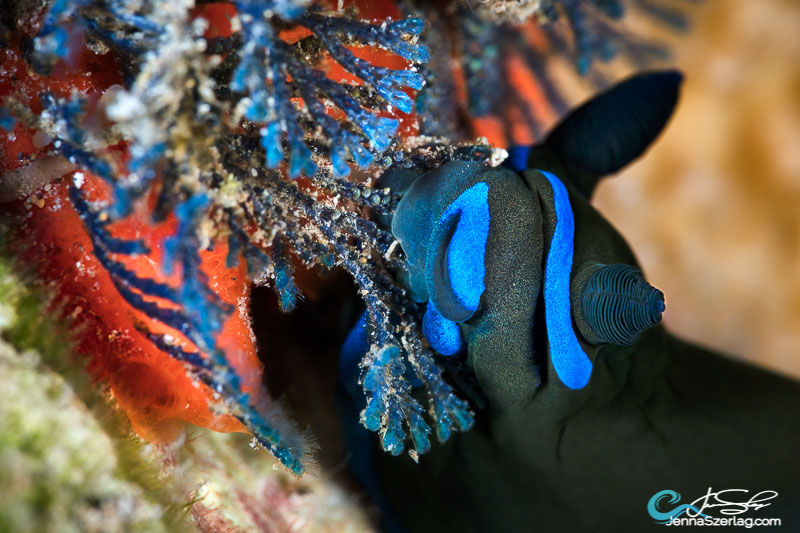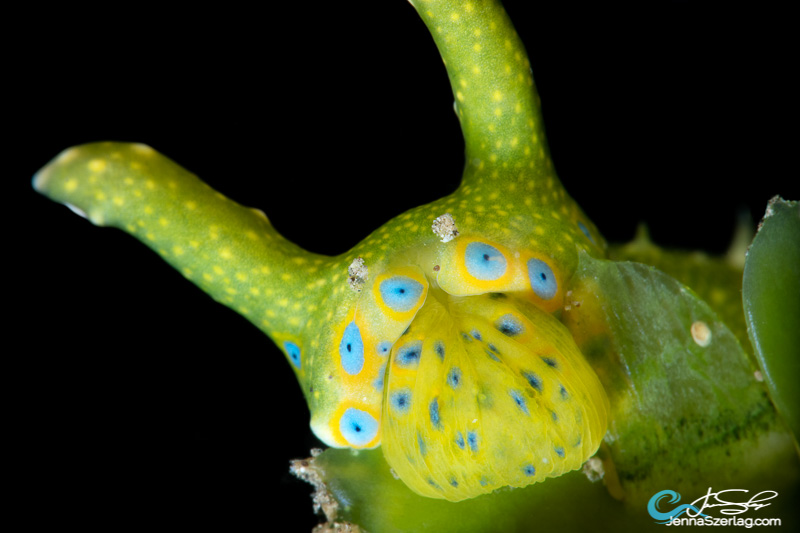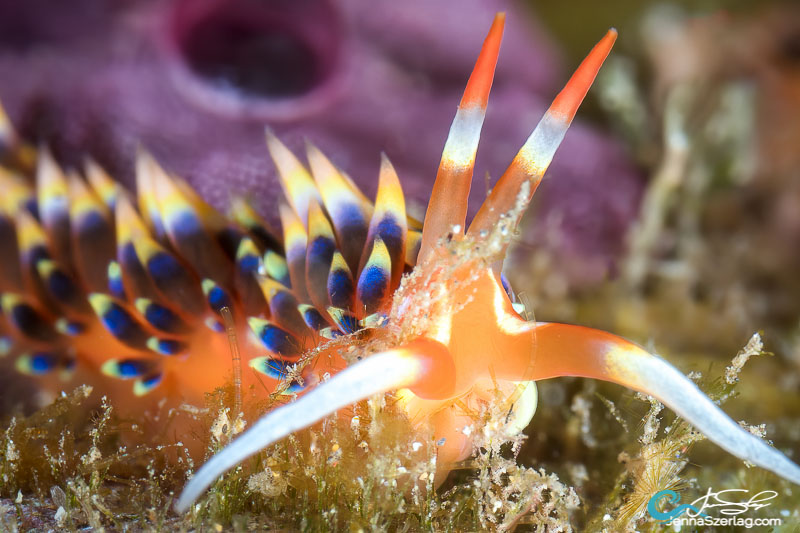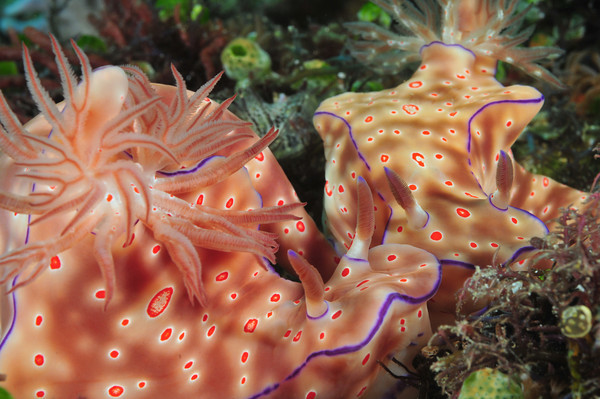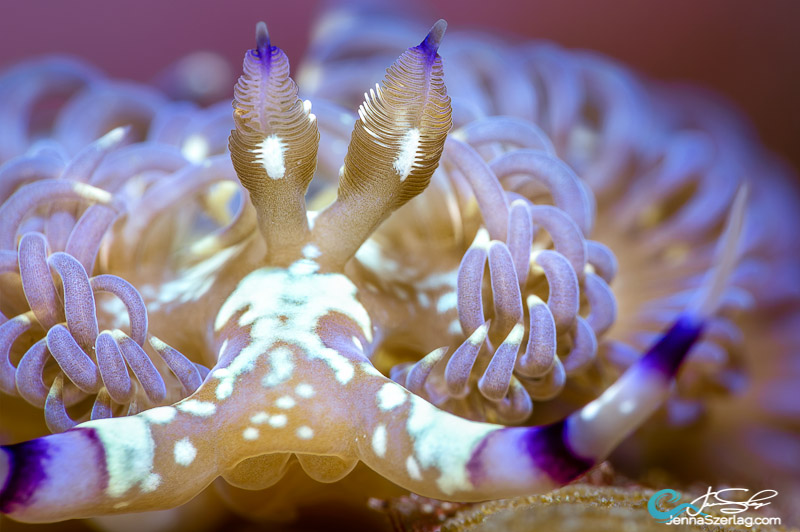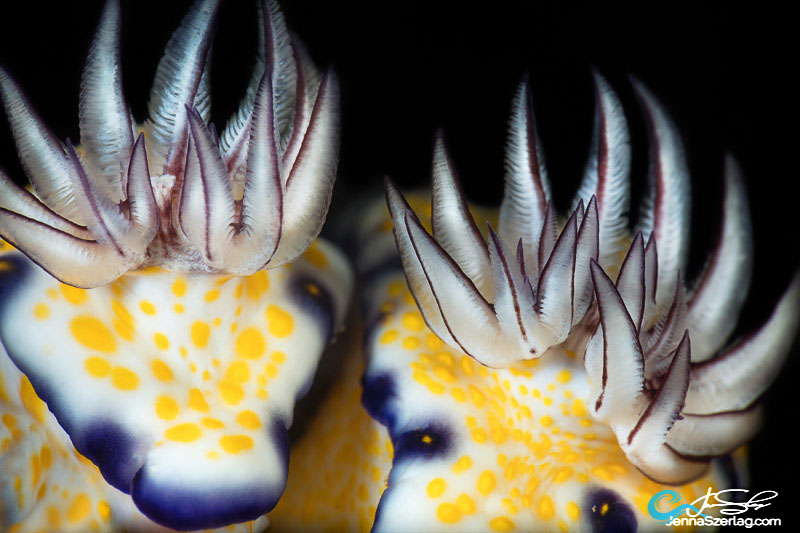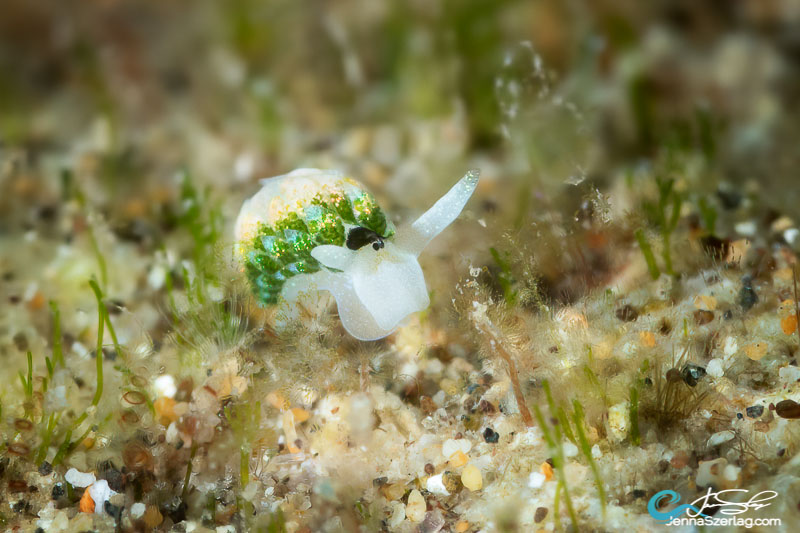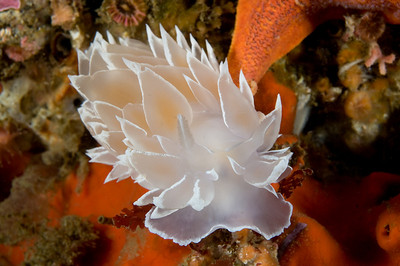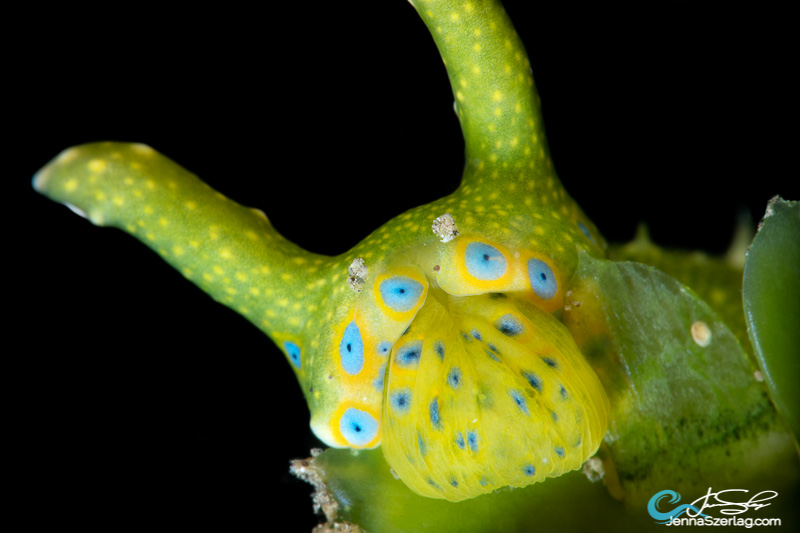
Nudibranchs are one of the most sought after macro subjects in underwater photography. Their brilliant colors and various shapes create impressive images that attract viewers. They move slowly and often stay still which allows the photographer time to capture incredible detail and compose the perfect shot.
JUMP TO:
Best Dive Locations to Find Sea Slugs
Tips for Photographing Nudibranchs
Be sure to read all of our Nudibranch Photo Tutorials, including:
How to Find Nudibranchs
Essential Tips for Nudibranch Photography
A Guide To Underwater Macro Lenses
How to Photograph Nudibranchs
Several angles create visual interest but getting the rhinophores in focus is key. Rhinophores are the two rod-shaped “antennae” sticking up from the front of the animal. Sometimes it’s hard to distinguish the front end from the back but the rhinophores are always a tell tale sign. Take a look at the chart below to learn the anatomy of a nudibranch.
It is important to shoot from a low angle, either from the front or the side, but not from above. Images taken from above the animal are great ID shots but the images turn out a bit flat. Create a multidimensional feel to the scene by showing the animal within its environment, kind of like a bug’s eye view. Getting low can be difficult, but it pays off especially if you can find a nudibranch that’s on a little hill. I personally like a slightly off centered view of the front to include the rest of its body flowing away from the initial focal point. It not only adds depth to the image but it includes the ‘face’ and also shows the rest of the animal as well.
Several nudibranch families can retract their gills, located towards the posterior of the animal. Wait until the gills are out as they add fascinating detail and identifying properties to the animal. Getting the gills and rhinophores in focus at the same time would be great, but due to the depth of field, often times the animal would need be composed horizontally across the frame which is not always ideal.
What is the nudibranch doing? Your image will tell a story by capturing the animal’s behavior. Pay careful attention to the background so your subject looks separated from the rest of the photo. If possible, contrasting colors will make it look like it is popping out of its surroundings. Most sea slugs are small, so by moving your camera angle by just a couple of inches to either side provides a completely different background. Remember to never touch or move the animal itself. Buoyancy control is of utmost importance with macro photography.
Fun Fact: Nudibranch means “naked gills”
Get creative with the lighting. I like to include a bright well-lit background if the nudibranch is with its food source or if the surroundings are just generally colorful. Black backgrounds are incredible to showcase the animal’s detail. Getting a particular angle with open water (negative space) behind the animal is necessary to create a black background. The Oxynoe jordani in the image above was feeding on Caulerpa taxifolia, a native to Hawaii algae that stands at a maximum of 4 inches from the sandy bottom. A very low, almost upwards angle was needed to achieve a black background using the open water behind it. Other compositions work well also. Extra bonus points if you can get the animal with its eggs!
Editor’s Tip for Black Backgrounds: Find a subject with a lot of negative space behind it and shoot up. You’ll want to shoot with a high shutter speed and a small aperture (high f-stop) to help reduce the amount of ambient light. An underwater snoot can make creating a black background much easier.
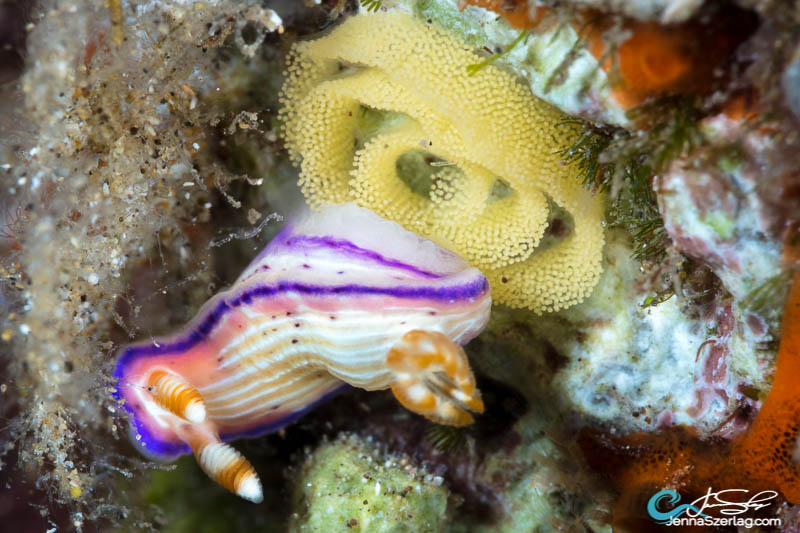
Tips for Photographing Nudibranchs
- Get low, get close, and try to fill the frame.
- Focus on the rhinophores. If the gills or rhinophores have retracted, be patient and wait for them to come out. If they have retracted, it’s likely the nudibranch has been disturbed. Be aware of your surroundings and make sure your presence or your silt is not bothering the animal.
- If your camera allows you to move its focus points, choose spot-focus, move the focal point to where the rhinophores are and compose your photo so the focus point lies over a rhinophore.
- Think about the kind of background you want – black background, background sharply in focus, or a background nicely blurred. All choices can make great underwater photographs. A good understanding of how aperture controls your depth of field will help with this.
- Learn how to position your strobes for front-lighting and side-lighting. Different sea slugs look better in different kinds of light.
- Use your histogram to avoid blowing out colors and highlights.
- To identify the animal, try to get the gills, rhinophores, oral tentacles, etc. in the frame
- Read about supermacro underwater photography, to photograph very small sea slugs.
- Please don’t harm an animal or move them from their environment just so you can get a better photograph, Sea slugs feed on very specific food sources.
- Compact camera users – read the lens selection section below, to understand how zooming in and zooming out affects your composition and background.
- Also read our articles ‘Essential Tips for Nudibranch Photography’ and ‘Macro Lenses for Underwater Photography’
What is a Nudibranch?
Nudibranchs are shell-less soft bodied animals in the phylum Mollusca, class Gastropoda, order Nudibranchia. Technically, the order nudibranchia falls under a subclass called Opisthobranchia, more commonly known as sea slugs. Most sea slugs have a reduction of or sometimes lack shells all together. Nudibranchia in particular, lack shells and have various forms of exposed secondary gills. But… not all sea slugs wear their gills on the outside of their bodies, therefore, all nudibranchs are sea slugs, but not all sea slugs are nudibranchs. Got it?
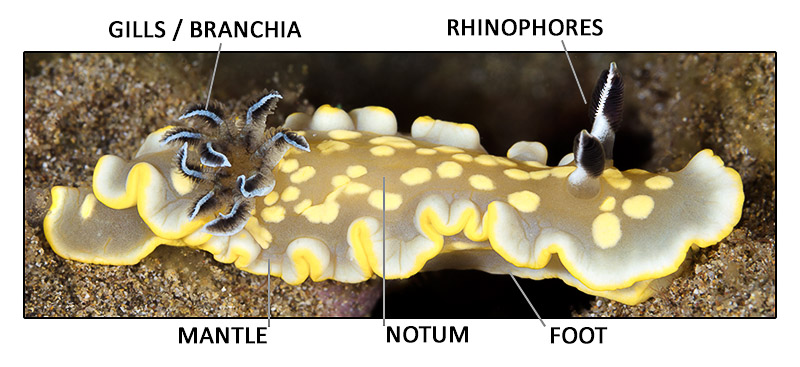
Common Terms Associated with Sea Slugs
Autotomize – Shedding or dropping of body parts assuming to distract from a predator
Branchia – Gills
Branchial Plume – One gill
Cephalic – Having to do with the head
Eye Spots – Simple eyes found on opisthobranchs
Foot – The organ located underneath the mollusk used for crawling
Gill – The structure used for respiration
Mantle – The tough outer layer of the animal
Notum – The upper surface of the animal
Ocellus (Ocelli) – Ring-like spots resembling eyes
Rhinophores – The sensory tentacles on top of the animal’s head on most opisthobranchs
Sea Slug – A member of the subclass opisthobranchia
Fun Fact: Some Aeolids can store nematocysts in their cerata, after they eat a Cnidarian such as a hydroid or anemone.
Natural History of Sea Slugs
New species of opisthobranchs are still being discovered today. Biologists have dedicated their careers to identifying new animals and researching their behaviors. The most common Nudibranchs found by divers are either Aeolids and Dorids. Nudibranchs are hermaphrodites (male and female) and are usually willing to mate with any other member of its species. Nudibranchs almost always begin their life as free-swimming planktonic larvae and feed on a particular hydroid, anemone, sponge, bryozoan or tunicate. Some nudibranchs that eat hydroids or anemones can store the nematocysts of their prey, using it for defense later. We most commonly spot them crawling around looking for food, but there are a few that can be surprisingly mobile and launch themselves into the water column and/or autotomize body parts when they feel threatened. Some nudibranchs, like some Phyllodesmium species, are solar-powered, getting energy and nutrition from symbiotic zooxanthellae that they absorb, much like corals do.
Excellent Dive Locations for Finding Nudibranchs
- Anilao, Philippines – Nudibranch capital of the world
- Puerto Galera and Dumaguete, Philippines also are good for sea slugs
- Central Visayas, Philippines (Moalboal, Cebu and Anda, Bohol)
- Lembeh straits, Sulawesi – you’ll find an excellent assortment of sea slugs here
- Bali, Indonesia – especially Jepun, Biaha, Seraya
- Loloata Island, Papau New Guinea
- Southern California – especially La Jolla shores, Palos Verdes and the northern Channel Islands
- Gulen, Norway (2 hours north of Bergen)
- Hawaii – Maui’s south and west shores and Kona, Big Island
- La Bufadora, Mexico
- Puerto Vallarta, Mexico
- Any of the muck diving locations in Hawaii, Asia Pacific will be excellent for nudibranchs
- Raja Ampat, Indonesia – diver Kevin Lee found 90 species here on a 10 day trip, almost as many as in Anilao
- Nelson Bay, Australia – just north of Sydney
- Byron Bay, Australia, near Julian Rocks (just south of Brisbane)
- Old woman island, 100km north of Brisbane. Garry Cobb does lots of branching here
- Australia has more great nudibranch sites. I saw quite a few at Edithburgh Jetty near Adelaide.
- Nha Trang, Vietnam
- Diving in Kenya, Africa. Read Kevin Lee’s article on all the amazing nudibranchs you can find in Kenya.
- Puget Sound, Washington
Lens Selection for Nudibranch Photography
-
Compact camera users – Zoom out to get the effect of the 60mm lens listed below. Zoom in all the way to get the effect of the 105mm lens. Wet lenses can give you additional macro capability for smaller nudibranchs.
-
60mm lens (cropped sensor camera) – good for photographing nudibranchs in their habitats, in-situ photographs. Auto-focus is fast, night photography is easy, and you can get close to the subject. Also good for low-visibility dives.
-
90mm, 100mm or 105mm lens (full frame camera) – great for isolating a nudibranch, filling the frame and blurring out the background. Also good for nudibranchs deep in reefs, cracks, crevices, etc – due to the increased working distance.
-
Fisheye lens – – this can be used if you’re lens has a close working distance to get very, very close to larger nudibranchs, for unique photographs that capture expansive backgrounds in the photograph. However, close focus lenses are required. Read about the unique Laowa 24mm f/14 Macro Probe Lens here.
-
Further reading on lens selection – A Guide To Macro Lenses
Further Reading
Best dive destinations for underwater photography
Muck and macro diving critter list
Super macro underwater photography
Advanced underwater composition (with some good ideas for Nudibranchs)
Story Behind the Shot: Melibe Nudibranch Congregation
California Sand Dwelling Nudibranchs
BEHAVIOR Captured: Nudibranch Self Defense in Action
Nudibranch resources
Inspirational Nudibranch photos by Kevin Lee
Marli Wakeling’s Nudibranchs of the world
Jim Anderson’s Scottish Nudibranch Page
Nudibranchs of the Mediterranean sea
Other Marine Life Articles
Leafy sea dragon – expert in camouflage
Bobbit Worm – ambush predator
Frogfish – Camouflaged ambush predators
Black Sea Bass – Gentle giants of California




